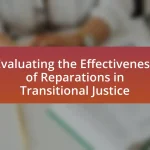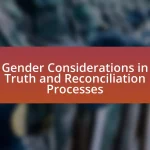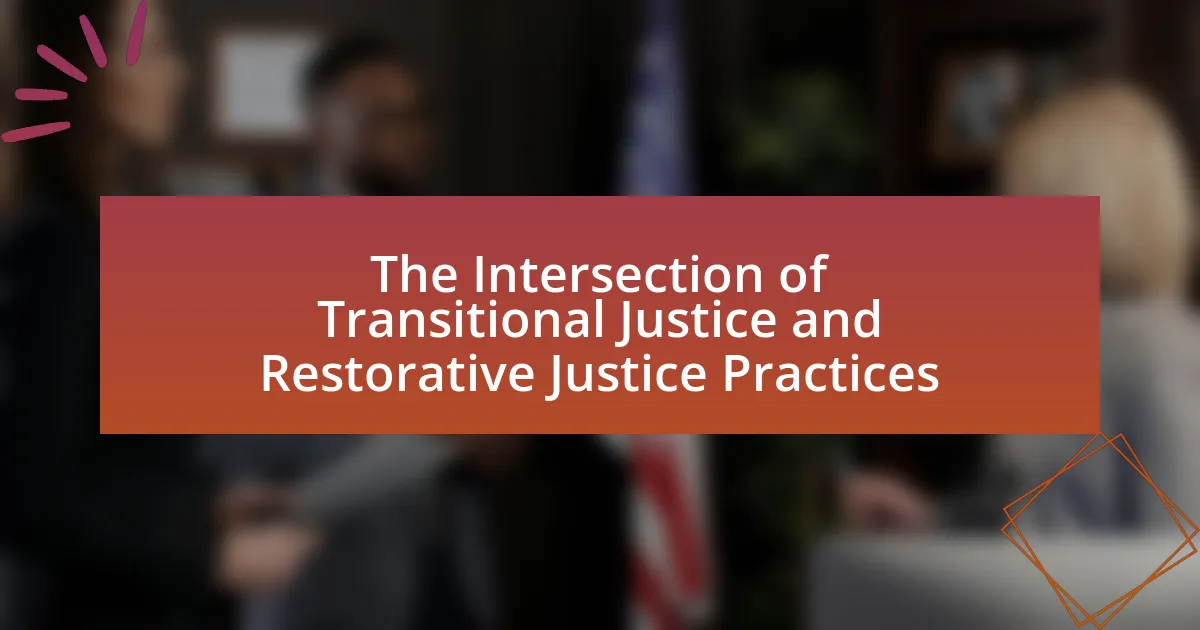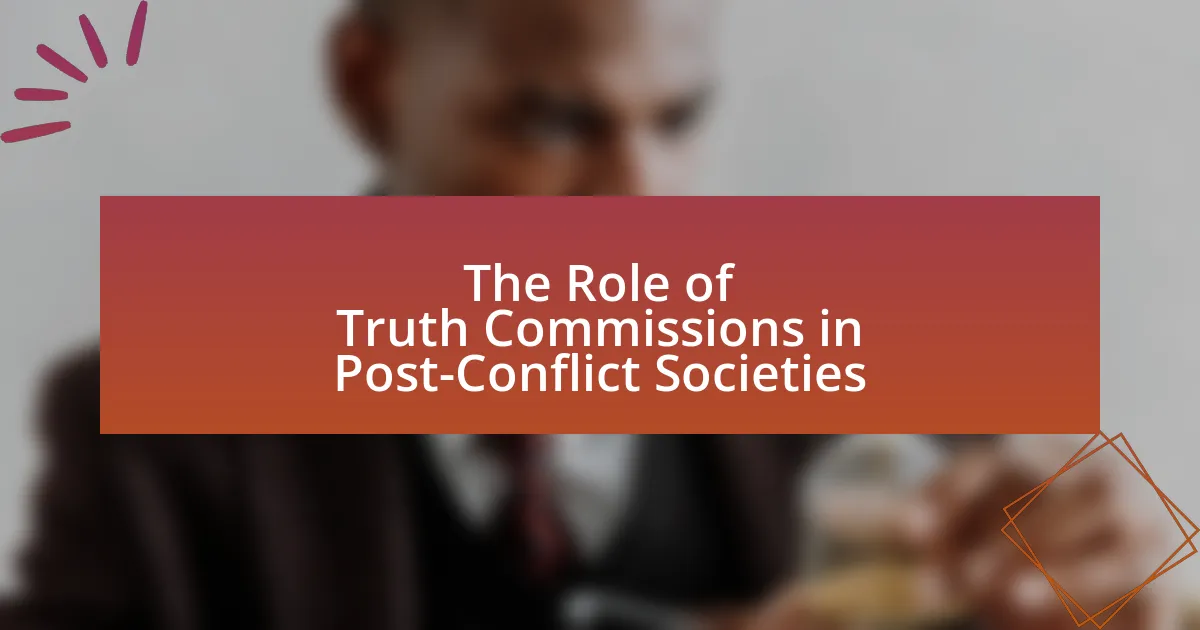Truth and reconciliation efforts are processes designed to address past human rights violations and promote healing in societies transitioning from conflict or authoritarian rule. This article examines the various approaches to truth and reconciliation across different countries, highlighting the influence of historical contexts and cultural factors on these initiatives. It discusses the importance of public participation, community involvement, and the role of narratives in fostering understanding and empathy. Additionally, the article outlines the challenges faced by these efforts, successful strategies, and lessons learned from historical cases, emphasizing the global implications and future trends in reconciliation practices.
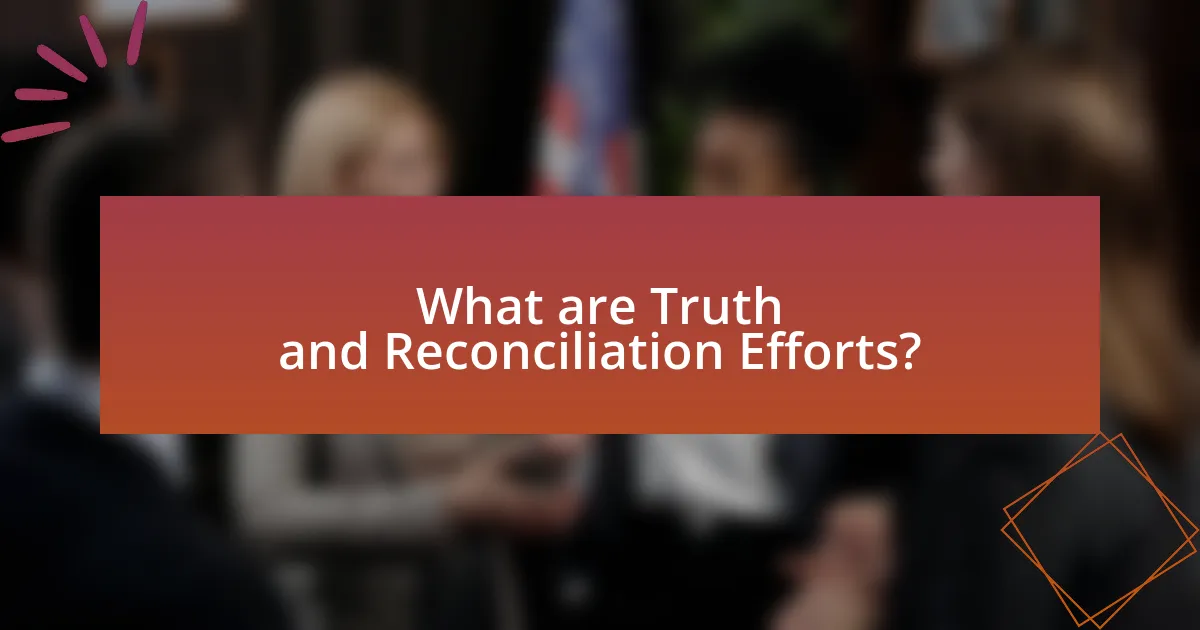
What are Truth and Reconciliation Efforts?
Truth and reconciliation efforts are processes aimed at addressing past human rights violations and fostering healing in societies transitioning from conflict or authoritarian rule. These efforts typically involve establishing truth commissions that investigate and document abuses, providing a platform for victims to share their experiences, and recommending measures for reparations and institutional reforms. For example, South Africa’s Truth and Reconciliation Commission, established in 1995, aimed to uncover the truth about apartheid-era atrocities and promote national unity, serving as a model for similar initiatives worldwide.
How do Truth and Reconciliation Efforts differ across countries?
Truth and reconciliation efforts differ across countries primarily in their approaches, structures, and outcomes. For instance, South Africa’s Truth and Reconciliation Commission focused on restorative justice and public hearings to address apartheid-era injustices, while Rwanda’s Gacaca courts emphasized community-based justice to deal with the aftermath of the genocide. These differences are influenced by historical contexts, societal needs, and political frameworks. In South Africa, the emphasis was on national unity and healing, whereas Rwanda prioritized accountability and community involvement. Such variations illustrate how the specific historical and cultural contexts shape the design and effectiveness of truth and reconciliation initiatives.
What historical contexts influence these efforts?
Historical contexts that influence truth and reconciliation efforts include colonialism, civil wars, and systemic oppression. For instance, post-apartheid South Africa’s Truth and Reconciliation Commission was shaped by decades of racial segregation and violence, aiming to address the injustices faced by the black majority. Similarly, the Rwandan Genocide’s aftermath necessitated reconciliation processes to heal a nation divided by ethnic conflict, highlighting the need for accountability and restorative justice. These contexts demonstrate that historical grievances and societal divisions significantly impact the design and implementation of reconciliation initiatives.
How do cultural factors shape the reconciliation process?
Cultural factors significantly shape the reconciliation process by influencing the values, beliefs, and practices that guide interactions between conflicting parties. For instance, in societies where collectivism is emphasized, reconciliation may focus on community healing and restoring social harmony, as seen in post-apartheid South Africa, where the Truth and Reconciliation Commission aimed to foster national unity through shared narratives. Additionally, cultural rituals and traditions can facilitate dialogue and understanding, as demonstrated in Indigenous reconciliation efforts in Canada, where cultural ceremonies play a crucial role in healing relationships. These examples illustrate that cultural context not only affects the methods employed in reconciliation but also the overall acceptance and effectiveness of the process.
Why are Truth and Reconciliation Efforts important?
Truth and reconciliation efforts are important because they facilitate healing and promote social cohesion in societies recovering from conflict or systemic injustice. These initiatives provide a platform for victims to share their experiences, acknowledge past wrongs, and foster mutual understanding among communities. For instance, the Truth and Reconciliation Commission in South Africa, established in 1995, aimed to address the atrocities of apartheid by documenting human rights violations and promoting restorative justice, which has been crucial in building a more inclusive society. Such efforts not only help to prevent the recurrence of violence but also contribute to the establishment of a historical record that can educate future generations about the consequences of division and injustice.
What role do they play in healing societies?
Truth and reconciliation efforts play a crucial role in healing societies by addressing historical injustices and fostering dialogue among affected communities. These processes facilitate acknowledgment of past wrongs, promote accountability, and encourage reparative measures, which are essential for rebuilding trust and social cohesion. For instance, the South African Truth and Reconciliation Commission, established in the 1990s, successfully helped to heal a divided nation by uncovering the truth about apartheid-era atrocities, allowing victims to share their experiences and promoting national unity. Such initiatives demonstrate that confronting the past can lead to restorative justice and a more harmonious society.
How do they contribute to justice and accountability?
Truth and reconciliation efforts contribute to justice and accountability by providing a platform for victims to share their experiences and for perpetrators to acknowledge their actions. These processes often lead to the establishment of factual historical records, which can validate the suffering of victims and hold offenders accountable. For instance, the South African Truth and Reconciliation Commission documented human rights violations during apartheid, allowing for public acknowledgment and reparations, thereby fostering societal healing and accountability. Such initiatives not only promote transparency but also encourage legal reforms and policy changes aimed at preventing future injustices.
What challenges do Truth and Reconciliation Efforts face?
Truth and reconciliation efforts face significant challenges, including political resistance, lack of public support, and insufficient resources. Political resistance often arises from those who fear accountability or loss of power, hindering the implementation of necessary reforms. Lack of public support can stem from a general mistrust in the process or differing views on historical narratives, which complicates consensus-building. Insufficient resources, both financial and human, limit the capacity of these efforts to effectively engage communities and sustain long-term initiatives. For instance, the South African Truth and Reconciliation Commission struggled with funding issues that affected its ability to carry out its mandate fully.
How do political dynamics impact these efforts?
Political dynamics significantly influence truth and reconciliation efforts by shaping the willingness of stakeholders to engage in dialogue and compromise. For instance, in post-apartheid South Africa, the political landscape facilitated the establishment of the Truth and Reconciliation Commission, which was supported by the ruling African National Congress, allowing for a structured process to address past injustices. Conversely, in countries like Rwanda, political tensions can hinder reconciliation efforts, as seen in the aftermath of the 1994 genocide, where ongoing ethnic divisions complicate the healing process. These examples illustrate that the success of reconciliation initiatives often hinges on the prevailing political climate and the commitment of political leaders to foster unity and address historical grievances.
What are the common obstacles to successful reconciliation?
Common obstacles to successful reconciliation include deep-seated mistrust, lack of political will, and insufficient resources. Mistrust often arises from historical grievances and trauma, making it difficult for parties to engage in meaningful dialogue. The absence of political will can hinder the implementation of reconciliation initiatives, as leaders may prioritize short-term gains over long-term peace. Additionally, inadequate resources, both financial and human, can limit the effectiveness of reconciliation efforts, preventing necessary programs from being established or sustained. These factors have been observed in various historical contexts, such as post-apartheid South Africa, where mistrust and political challenges significantly impacted the reconciliation process.
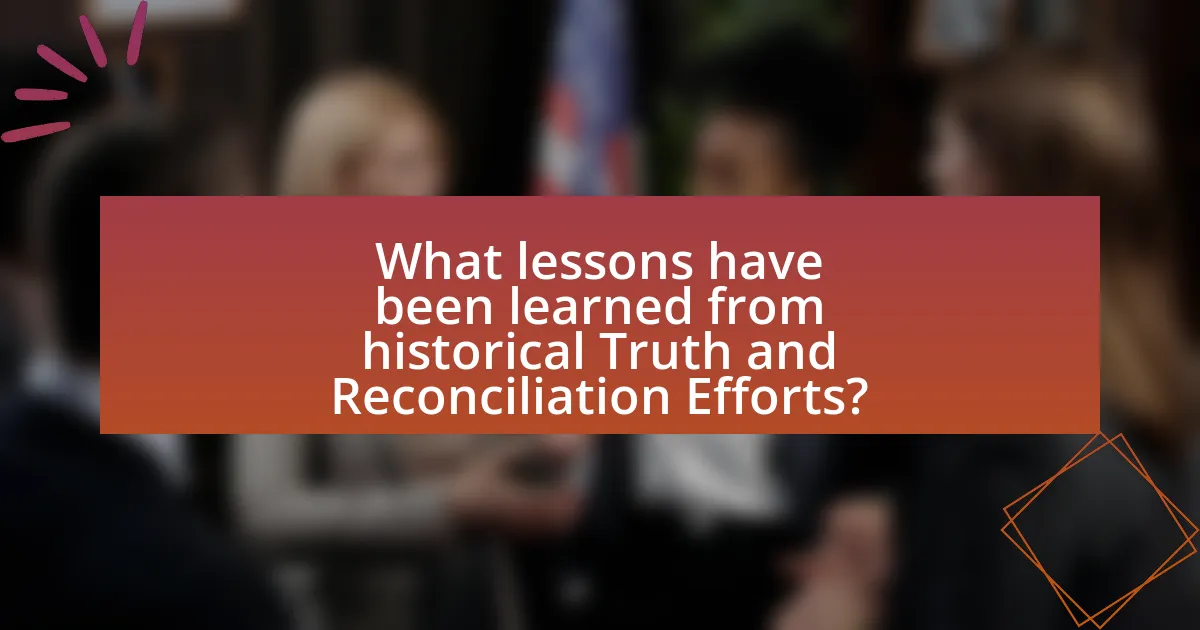
What lessons have been learned from historical Truth and Reconciliation Efforts?
Historical Truth and Reconciliation Efforts have demonstrated that acknowledging past injustices is crucial for healing and building trust within societies. These efforts, such as South Africa’s Truth and Reconciliation Commission, revealed that transparency and accountability are essential for addressing grievances and fostering reconciliation. Additionally, they highlighted the importance of including diverse voices, particularly those of marginalized communities, to ensure a comprehensive understanding of historical injustices. Studies indicate that successful reconciliation processes often lead to improved social cohesion and reduced conflict, as seen in countries like Rwanda, where post-genocide reconciliation initiatives contributed to national unity.
How have different countries approached reconciliation?
Different countries have approached reconciliation through various mechanisms tailored to their unique historical contexts and societal needs. For instance, South Africa implemented a Truth and Reconciliation Commission (TRC) post-apartheid, focusing on uncovering the truth about human rights violations and fostering national unity. In contrast, Rwanda established a Gacaca court system after the 1994 genocide, emphasizing community-based justice and dialogue to address the crimes and promote healing. Additionally, Canada has engaged in reconciliation efforts with Indigenous peoples through the Truth and Reconciliation Commission, which aimed to address the legacy of residential schools and promote healing through acknowledgment and reparations. These examples illustrate that reconciliation strategies can vary significantly, often reflecting the specific historical injustices and cultural contexts of each nation.
What successful strategies have emerged from these efforts?
Successful strategies that have emerged from historical truth and reconciliation efforts include the establishment of truth commissions, community engagement initiatives, and reparative justice measures. Truth commissions, such as South Africa’s Truth and Reconciliation Commission, have effectively documented human rights abuses and facilitated public dialogue, leading to national healing and acknowledgment of past injustices. Community engagement initiatives, like those seen in Canada with Indigenous reconciliation efforts, foster collaboration and understanding between affected communities and governments, promoting healing through shared narratives. Reparative justice measures, including financial compensation and land restitution, have been implemented in various contexts, such as in post-conflict societies, to address historical grievances and support affected populations. These strategies demonstrate the importance of transparency, inclusivity, and accountability in fostering reconciliation and building a more just society.
What mistakes have been made, and what can be learned from them?
Mistakes made in historical truth and reconciliation efforts include insufficient community involvement, lack of transparency, and failure to address underlying power imbalances. For instance, in South Africa’s Truth and Reconciliation Commission, the limited engagement with marginalized communities led to feelings of exclusion and distrust. This highlights the importance of inclusive processes that genuinely reflect the voices of all affected parties. Additionally, the absence of clear accountability mechanisms often results in a lack of trust in the outcomes, as seen in the case of Argentina’s transitional justice efforts, where many perpetrators of human rights abuses were not held accountable. Learning from these mistakes emphasizes the necessity for comprehensive stakeholder engagement, transparency in proceedings, and robust accountability measures to foster genuine reconciliation and healing.
What role does public participation play in reconciliation?
Public participation is essential in reconciliation as it fosters inclusivity and empowers communities to engage in the healing process. By involving diverse voices, public participation ensures that the narratives and experiences of all affected groups are acknowledged, which is crucial for building trust and understanding. Historical examples, such as South Africa’s Truth and Reconciliation Commission, demonstrate that public engagement can lead to greater accountability and collective healing, as it allows victims to share their stories and promotes dialogue among different societal factions. This participatory approach not only validates individual experiences but also contributes to a shared understanding of past injustices, ultimately facilitating a more comprehensive and sustainable reconciliation process.
How can community involvement enhance the process?
Community involvement can enhance the process of truth and reconciliation by fostering trust and collaboration among stakeholders. Engaging local communities ensures that diverse perspectives are included, which can lead to more comprehensive and representative outcomes. For instance, the South African Truth and Reconciliation Commission demonstrated that involving communities in dialogue helped to address grievances and promote healing, ultimately contributing to national unity. This approach not only validates the experiences of marginalized groups but also encourages collective ownership of the reconciliation process, making it more effective and sustainable.
What are the effects of grassroots movements on reconciliation efforts?
Grassroots movements significantly enhance reconciliation efforts by fostering community engagement and promoting dialogue among affected populations. These movements often serve as catalysts for change, mobilizing individuals to address grievances and advocate for justice. For instance, the Truth and Reconciliation Commission in South Africa was influenced by grassroots activism, which highlighted the need for acknowledgment of past injustices and facilitated healing processes. Additionally, research indicates that grassroots initiatives can lead to increased trust in institutions and greater participation in democratic processes, as seen in various post-conflict societies where local organizations played a pivotal role in rebuilding social cohesion.
How do narratives and storytelling influence reconciliation?
Narratives and storytelling significantly influence reconciliation by shaping collective memory and fostering empathy among conflicting parties. Through shared stories, individuals can understand diverse perspectives, which is essential for healing and rebuilding trust. For instance, the Truth and Reconciliation Commission in South Africa utilized personal testimonies to highlight the experiences of victims and perpetrators, facilitating dialogue and understanding. This approach demonstrated that storytelling can bridge divides, as it allows for the acknowledgment of pain and the validation of experiences, ultimately contributing to a more cohesive society.
What impact do personal testimonies have on collective memory?
Personal testimonies significantly shape collective memory by providing individual perspectives that enrich the shared understanding of historical events. These narratives often highlight emotional truths and personal experiences that statistics and historical accounts may overlook, thereby fostering empathy and connection among communities. For instance, in the context of truth and reconciliation efforts, such as those in South Africa post-apartheid, personal testimonies from victims and perpetrators alike have been crucial in acknowledging past injustices and facilitating healing. Research by scholars like Priscilla Hayner emphasizes that these testimonies can serve as a bridge between individual experiences and collective narratives, ultimately influencing how societies remember and learn from their histories.
How can narratives be used to foster understanding and empathy?
Narratives can foster understanding and empathy by providing personal and relatable accounts of experiences, which allow individuals to connect emotionally with others’ perspectives. For instance, storytelling in truth and reconciliation processes, such as South Africa’s post-apartheid efforts, has been shown to humanize historical injustices and promote dialogue among diverse groups. Research indicates that narratives can reduce prejudice and increase empathy by illustrating the complexities of human experiences, as evidenced by studies conducted by psychologists like Melanie Green and Timothy Brock, who found that engaging with narratives can lead to greater emotional engagement and perspective-taking.
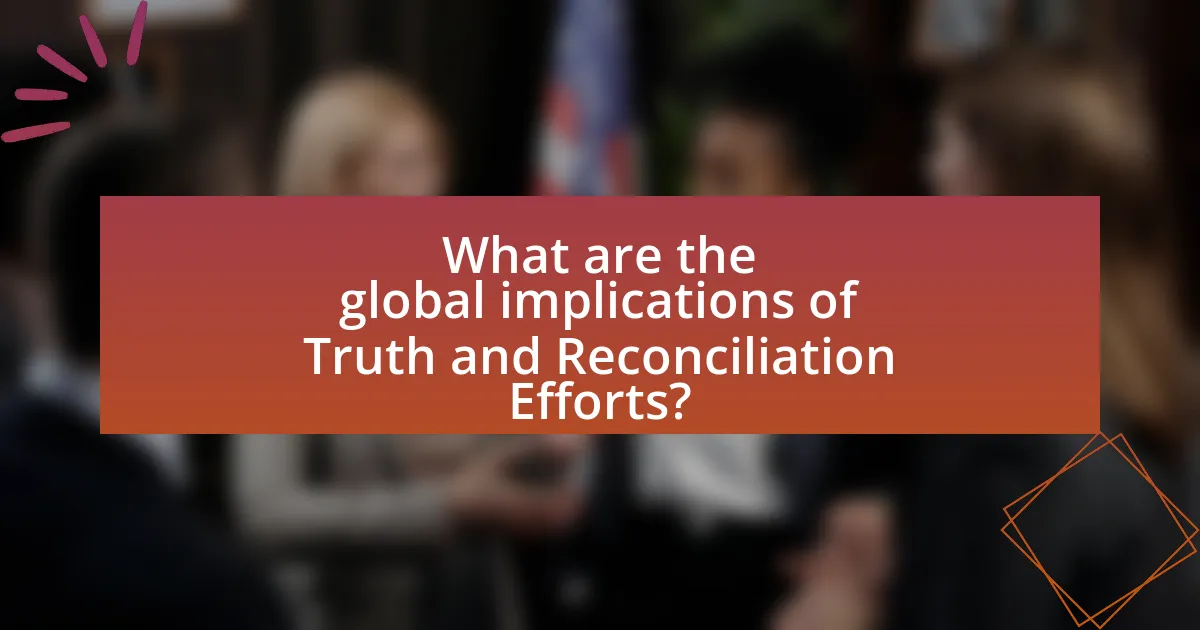
What are the global implications of Truth and Reconciliation Efforts?
Truth and reconciliation efforts have significant global implications, primarily fostering healing, promoting justice, and enhancing social cohesion in post-conflict societies. These initiatives, such as South Africa’s Truth and Reconciliation Commission, demonstrate how addressing historical injustices can lead to national healing and the establishment of democratic governance. Research indicates that countries engaging in truth and reconciliation processes often experience reduced levels of violence and improved human rights conditions, as seen in the cases of Rwanda and Canada. Furthermore, these efforts can inspire similar movements worldwide, encouraging nations to confront their pasts and work towards a more equitable future.
How can lessons from one country inform others?
Lessons from one country can inform others by providing insights into effective strategies and potential pitfalls in truth and reconciliation processes. For example, South Africa’s Truth and Reconciliation Commission (TRC) demonstrated the importance of public testimony in healing societal wounds, which has been referenced by countries like Rwanda and Canada in their own reconciliation efforts. The TRC’s approach to acknowledging past injustices and fostering dialogue has been studied extensively, showing that such frameworks can promote national healing and unity. Additionally, comparative analyses reveal that countries adopting similar restorative justice practices often experience improved social cohesion and reduced conflict, underscoring the value of learning from established models.
What examples exist of cross-border learning in reconciliation?
Examples of cross-border learning in reconciliation include the collaboration between South Africa and Rwanda in sharing experiences from their respective truth and reconciliation commissions. South Africa’s Truth and Reconciliation Commission (TRC), established in 1995, provided a model for Rwanda, which implemented its own National Unity and Reconciliation Commission in 1999 following the genocide. Both countries focused on restorative justice and community healing, demonstrating how one nation’s approach can inform another’s reconciliation efforts. Additionally, the European Union’s support for cross-border reconciliation initiatives in the Balkans, particularly through programs that promote dialogue and cooperation among former adversaries, illustrates another instance of cross-border learning in reconciliation. These examples highlight the importance of shared experiences and strategies in addressing historical grievances and fostering peace.
How can international organizations support these efforts?
International organizations can support truth and reconciliation efforts by providing funding, expertise, and facilitating dialogue among stakeholders. For instance, organizations like the United Nations have historically allocated resources to support transitional justice initiatives, as seen in countries like South Africa and Rwanda, where they helped establish truth commissions. Additionally, international organizations can offer technical assistance in developing frameworks for accountability and reparations, drawing on best practices from previous successful cases. Their involvement can enhance credibility and foster trust among communities, ultimately contributing to sustainable peace and healing.
What are the future trends in Truth and Reconciliation Efforts?
Future trends in Truth and Reconciliation efforts include a greater emphasis on community-led initiatives and the integration of technology to enhance transparency and accessibility. Community-led initiatives are increasingly recognized for their ability to foster local ownership and engagement, as seen in various successful models worldwide, such as the South African Truth and Reconciliation Commission, which highlighted the importance of grassroots participation. Additionally, the use of technology, including digital platforms for documenting testimonies and sharing resources, is becoming more prevalent, as evidenced by projects like the “Memory Project” in Canada, which utilizes multimedia to preserve and disseminate stories of Indigenous experiences. These trends indicate a shift towards more inclusive and innovative approaches in addressing historical injustices.
How is technology shaping the reconciliation process?
Technology is shaping the reconciliation process by facilitating communication, enhancing transparency, and providing platforms for documentation and storytelling. Digital tools, such as social media and online forums, enable diverse voices to participate in dialogues, fostering a more inclusive environment for sharing experiences related to historical injustices. For instance, the use of mobile applications and websites allows victims to document their stories and access resources, which can be crucial for healing and recognition. Additionally, data analytics can help organizations identify patterns of injustice and track progress in reconciliation efforts, as seen in various truth commissions worldwide. These technological advancements contribute to a more informed and engaged public, ultimately supporting the reconciliation process.
What emerging practices are being adopted globally?
Emerging practices being adopted globally include restorative justice approaches, community-based reconciliation initiatives, and the integration of technology in truth-telling processes. Restorative justice focuses on repairing harm through dialogue and accountability, as seen in countries like South Africa and Canada, where truth commissions have facilitated healing. Community-based reconciliation initiatives empower local populations to address historical grievances, fostering grassroots participation and ownership, exemplified by programs in Rwanda and Colombia. Additionally, the use of technology, such as digital platforms for documenting testimonies and sharing narratives, enhances accessibility and engagement, as demonstrated by projects like the Truth and Reconciliation Commission’s online archives in Canada. These practices reflect a shift towards inclusive, participatory methods in addressing historical injustices.
What practical steps can be taken to improve reconciliation efforts?
To improve reconciliation efforts, establishing inclusive dialogue platforms is essential. These platforms facilitate open communication among affected communities, allowing for the sharing of experiences and grievances. For instance, the Truth and Reconciliation Commission in South Africa successfully utilized public hearings to promote understanding and healing among diverse groups. Additionally, implementing educational programs that focus on the history and impact of conflicts can foster empathy and awareness, as seen in post-genocide Rwanda, where educational reforms aimed at promoting unity have been pivotal. Finally, ensuring that reparations and restorative justice measures are part of the reconciliation process can address historical injustices, as evidenced by the reparations programs in Canada for Indigenous peoples, which aim to rectify past wrongs and build trust.
What best practices should be followed in future initiatives?
Future initiatives should prioritize inclusivity, transparency, and community engagement. Inclusivity ensures that all affected groups have a voice, which is crucial for building trust and legitimacy; for example, the South African Truth and Reconciliation Commission included diverse perspectives, leading to broader acceptance of its findings. Transparency in processes and decision-making fosters accountability, as seen in the Canadian Truth and Reconciliation Commission, where public access to information helped maintain public trust. Community engagement is vital for ensuring that initiatives are culturally relevant and supported by local populations, as demonstrated by the participatory approaches used in various reconciliation efforts in Rwanda. These best practices are essential for the success and sustainability of future truth and reconciliation initiatives.
How can stakeholders collaborate for effective reconciliation?
Stakeholders can collaborate for effective reconciliation by establishing open communication channels, fostering mutual respect, and engaging in joint decision-making processes. Open communication allows stakeholders to share their perspectives and grievances, which is essential for understanding the complexities of historical injustices. For instance, the Truth and Reconciliation Commission in South Africa emphasized dialogue among diverse groups to address past wrongs, leading to a more inclusive reconciliation process. Mutual respect among stakeholders encourages a willingness to listen and learn from each other, which is critical in building trust. Joint decision-making ensures that all voices are heard and considered, as demonstrated by the collaborative efforts in Canada’s reconciliation with Indigenous peoples, where co-developed policies have led to more effective outcomes. These collaborative strategies are supported by evidence from various global reconciliation efforts, highlighting their importance in achieving lasting peace and understanding.

